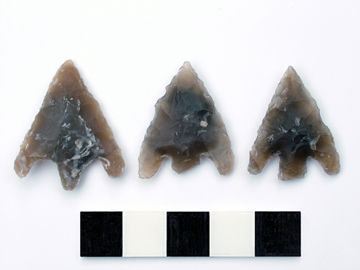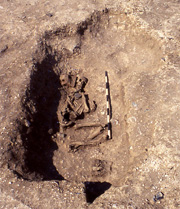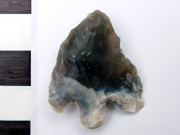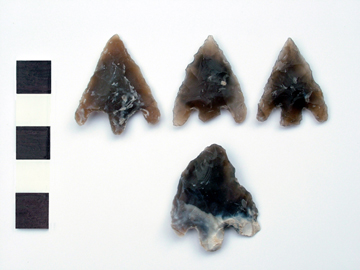
Return to QEQM main Display
Display Contents
QEQM Hospital, Margate
Link -
The flint arrowheads
The Beaker burial
Contexts of use
Green Low
Conygar Hill
Observations
The secondary grave
Contexts of use
Observations
Scales in centimetre divisions
Link - The flint arrowheads

They may be only the third such occurrence recorded in Kent, with single examples known from Cliffe (Kinnes et al 1998) and possibly Sittingbourne (though this is uncertain). They likely comprise the largest assemblage recovered so far.
The QEQM Beaker burial
barbed and tanged
flint arrowheads
barbed and tanged
flint arrowheads
Small Finds 1, 2 and 3
(Left to right)

All were finely bifacially and invasively pressure-flaked. Thicknesses varied from 4.5-5.5mm and they weighed less than 2g each. Two of the arrowheads retained very small areas of the original surface of the flake 'blank', while another featured a little remnant of buff-coloured cortex.
Conygar
Hill type arrowhead from the QEQM Beaker burial
Small Find 1
This was the first arrowhead to appear, discovered by our Webmeister Ges Moody
Reverse of Small Find 1
Two are of Conygar Hill type (Small Finds 1 and 3) while the third appears to be of Green Low type (Small Find 2), though it lacks the distinctly obliquely-cut barbs of the classic form.
All three arrowheads feature some slight differences to the classical forms, though the differences in the case of the Conygar Hill arrowheads would appear to be negligible.
The differences in these two
arrowhead classes represent intentional formal types. Green's research
(1980) has highlighted the differences in the contexts where these two
types are normally found and this is sumarised below:
Small Find 3
Note the small area of buff-coloured cortex left on the surface of the arrowhead
This is a remnant of the original outer surface of the raw flint core from which the flake-blank was struck


Reverse of Small Find 3
These are found throughout
Britain, frequently with Early Bronze Age Food Vessels and are most
frequently associated with cremation burials.
However, 'in no cases do finely finished examples occur in association with Beakers' (Green 1980).
By 1980 Green had found only three associations with Early British Beakers, all crude examples. These he considered might be explicable as random typological variants.
A grave group at Stonehenge produced one, possibly two Conygar arrowheads in a grave containing a wristguard (and therefore denoting it as a Beaker grave), but in this case the arrowheads were the cause of death and not grave goods. Two associations at Stanton Harcourt and Olchon were with Netherlands/Mid Rhine Beakers, 'who's northerly distribution is comparable to that of Food Vessels (Clarke 1970, 559-562)'.
However, 'in no cases do finely finished examples occur in association with Beakers' (Green 1980).
By 1980 Green had found only three associations with Early British Beakers, all crude examples. These he considered might be explicable as random typological variants.
A grave group at Stonehenge produced one, possibly two Conygar arrowheads in a grave containing a wristguard (and therefore denoting it as a Beaker grave), but in this case the arrowheads were the cause of death and not grave goods. Two associations at Stanton Harcourt and Olchon were with Netherlands/Mid Rhine Beakers, 'who's northerly distribution is comparable to that of Food Vessels (Clarke 1970, 559-562)'.
This indicates a date which is
'uncalibrated' and could be perhaps up to 400 years younger
than their true 'calibrated' calender date (in this particular case).
A calibrated date is expressed as BC (upper case)
A calibrated date is expressed as BC (upper case)
from the QEQM Beaker burial
Small Find 2

Reverse of Small Find 2
They are largely restricted to the distribution area of Southern Beakers (Clarke 1970, maps 7-10), suggesting they were an exclusive Southern Beaker type, associated with S1-S3 Beakers (Clarke 1970). One has been found with an N2 Beaker, at Winterbourne Monkton, barrow 9. They do occur with creations, but are most frequently associated with inhuming Beaker groups (shown by a ratio of 3:1 inhumation to cremation burials).
They are not found with Early Bronze Age Food Vessels or Urns, though their period of use overlaps in time with both. Where they have been found without Beakers 'it is in contexts which are quite possibly aceramic Beaker burials; for example at Sixpenny Hill and Aldwinkle Barrow 1' (Green 1980).
In Wessex they occur with a below-average frequency. The only evidence for the survival of this type beyond the terminal date for Southern Beakers c.1400 bc, is from a somewhat unsatisfactory association at Mount Pleasant.

The QEQM Beaker burial
Observations
Green’s extensive study of flint arrowheads (1980) allowed him to establish parameters and trends regarding their dates, associations and contexts of use. In reference to this, it can be seen that the presence of the QEQM Green Low arrowhead is not unexpected in this context. However it would appear to be occurring with a slightly earlier vessel form than normally expected (in this case a Step 3 Beaker), while also lacking the obliquely-cut barbs of Green's (1980) classic form.
Green’s extensive study of flint arrowheads (1980) allowed him to establish parameters and trends regarding their dates, associations and contexts of use. In reference to this, it can be seen that the presence of the QEQM Green Low arrowhead is not unexpected in this context. However it would appear to be occurring with a slightly earlier vessel form than normally expected (in this case a Step 3 Beaker), while also lacking the obliquely-cut barbs of Green's (1980) classic form.
The two Conygar Hill
arrowheads are of a type which (prior to 1980 at
least) were not thought to occur with Beakers when in ‘finely finished’
form. The two examples from QEQM therefore appear to be at odds with
the general trend observed by Green. The differences of these two
arrowheads from the classical form are so slight as to be most likely
of little significance in that regard.
It may be that these arrowheads were made intentionally as prestigious objects, perhaps specifically for the subject of this burial.
However, the presence of 'fancy' arrowhead types in other contexts elsewhere indicate that they must also have been in everyday use (Green 1980).
It may be that these arrowheads were made intentionally as prestigious objects, perhaps specifically for the subject of this burial.
However, the presence of 'fancy' arrowhead types in other contexts elsewhere indicate that they must also have been in everyday use (Green 1980).


Reverse of the Sutton B type arrowhead from the
QEQM secondary burial
The arrowhead was of
'non-fancy' Sutton B type (Green 1980) and was much thicker
(6.5mm, 4g) and cruder than the three arrowheads recovered from the
adjacent Beaker grave.
It had been invasively retouched around its margins only, leaving much of the original flake surface intact. This showed that the raw material may had been obtained from a weathered surface deposit.
The retouching varied from shallow flakes to biting, semi-abrupt scars, though nearly all the larger scars were feather terminated. One of the barbs was slightly pointed, the other was oblique and both were shorter than the rounded tang.
It was somewhat asymmetrical (which may represent reworking) but was otherwise fresh and might also have been made for depositing with the body - though by a much less skilled flintknapper than the one who made the Beaker burial arrowheads.
It had been invasively retouched around its margins only, leaving much of the original flake surface intact. This showed that the raw material may had been obtained from a weathered surface deposit.
The retouching varied from shallow flakes to biting, semi-abrupt scars, though nearly all the larger scars were feather terminated. One of the barbs was slightly pointed, the other was oblique and both were shorter than the rounded tang.
It was somewhat asymmetrical (which may represent reworking) but was otherwise fresh and might also have been made for depositing with the body - though by a much less skilled flintknapper than the one who made the Beaker burial arrowheads.
Green's research (1980)
showed that the 'B' form of Sutton type
arrowheads, while 'omni-present', occured with particular frequency in
Beaker Archer's graves
and it would seem that 'everyday arrowhead forms were typically placed
in such a context in contrast to a preference for finely finished and
therefore sometimes non-utilitarian forms in Food Vessel, Urn and other
Early Bronze Age burials' (Green 1980).
The secondary burial at QEQM
This arrowhead was
recovered from inside the skull during post-excavation work. An
identical occurrence to this was seen in the recovery of a somewhat
crude scraper from the skull of a ‘Late’ Beaker
burial discovered at Beauforts, North Foreland Avenue, Broadstairs
(Hart 2005)
Similarly at the ‘Late’
Beaker burial at
Manston Runway Approach a flint knife was said to have been recovered
from near the skull of that burial. Some disturbance of this
grave had been noted however (Perkins and Gibson 1990; Jay 1995).
Could a growing frequency
of
these associations suggest a possible trend? It may be that some
grave-goods were placed upon or very close to the head of the
deceased. However the crudeness of the form of the Thanet examples
(with the possible exception of
the
Manston flint knife, which was skillfully struck but not retouched)
might argue against such a deliberate,
devotional
act perhaps.
Another factor to consider is what was the degree of post-depositional disturbance that the graves may have suffered (either through human or animal agencies) if objects postulated as primary grave-goods were actually recovered from the grave fills rather than the base of the grave cut.
Another factor to consider is what was the degree of post-depositional disturbance that the graves may have suffered (either through human or animal agencies) if objects postulated as primary grave-goods were actually recovered from the grave fills rather than the base of the grave cut.

Green H. Stephen 1980. The flint arrowheads of the British Isles. BAR British Series 75.
Hart P.C. 2005. Beauforts, North Foreland Avenue, Broadstairs, Kent. Trust for Thanet Archaeology report.
Hart P.C. 2006. The Flintwork in Gardner O.W. and Moody G.A. Queen Elizabeth the Queen Mother Hospital, St. Peter’s Road, Margate, Kent. Trust for Thanet Archaeology report, Part 5.
Jay L. 1995. Thanet Beakers. Trust for Thanet Archaeology.
Kinnes I., Cameron F., Trow S., and Thomson D. 1998. Excavations at Cliffe, Kent. British Museum Occasional Paper no. 69.
Perkins D.R.J. and Gibson A.M. 1990. A Beaker burial from Manston, near Ramsgate. Archaeologia Cantiana CVIII.
Many thanks goes to Maggy Redmond for her illustration of these arrowheads and other pieces of flintwork from the excavations at QEQM.
Version 1 - Posted 16.12.06
All
content © Trust for Thanet Archaeology